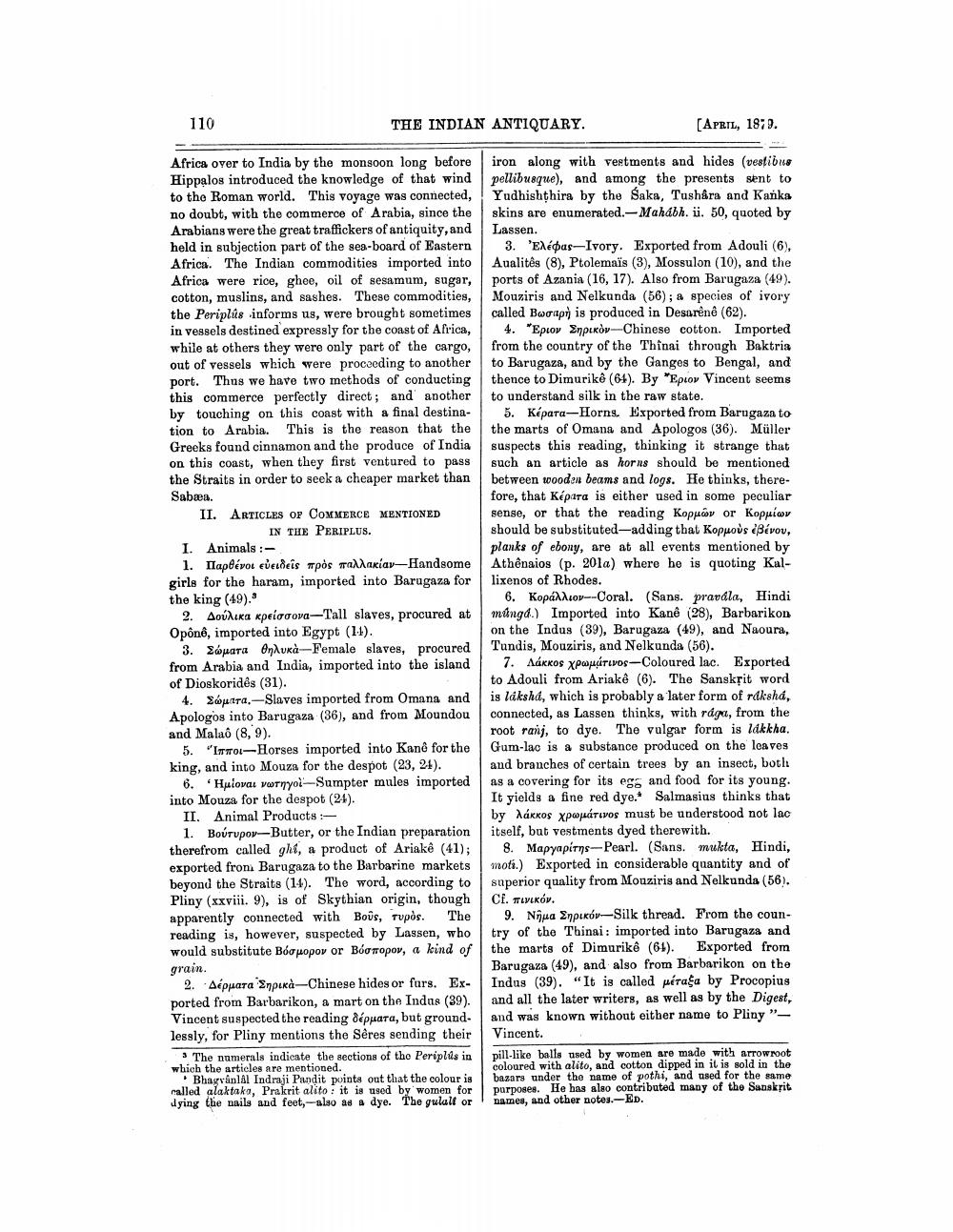________________
110
THE INDIAN ANTIQUARY.
[APRIL, 1879.
Africa over to India by the monsoon long before Hippalos introduced the knowledge of that wind to the Roman world. This voyage was connected, no doubt, with the commerce of Arabia, since the Arabians were the great traffickers of antiquity, and held in subjection part of the sea-board of Eastern Africa. The Indian commodities imported into Africa were rice, ghee, oil of sesamum, sugar, cotton, muslins, and sashes. These commodities, the Periplús informs us, were brought sometimes in vessels destined expressly for the coast of Africa, while at others they were only part of the cargo, out of vessels which were proceeding to another port. Thus we have two methods of conducting this commerce perfectly direct; and another by touching on this coast with a final destination to Arabia. This is the reason that the Greeks found cinnamon and the produce of India on this coast, when they first ventured to pass the Straits in order to seek a cheaper market than Sabæa. II. ARTICLES OF COMMERCE MENTIONED
IN THE PERIPLUS. I. Animals :
1. Ilapbévot eveideis após mallariar-Handsome girls for the haram, imported into Barugaza for the king (49).
2. Aoúluka kpelosova-Tall slaves, procured at Opônê, imported into Egypt (1.4).
3. Súpara Onluka-Female slaves, procured from Arabia and India, imported into the island of Dioskoridês (31).
4. Sutra.-Slaves imported from Omana and Apologos into Barugaza (36), and from Moundou and Malað (8,9).
5. "IT70-Horses imported into Kand for the king, and into Mouza for the despot (23, 24).
6. 'Hulovai vorryol-Sumpter mules imported into Mouza for the despot (24).
II. Animal Products :
1. Boúrupor-Butter, or the Indian preparation therefrom called ghi, a product of Ariakê (41); exported from Barugaza to the Barbarine markets beyond the Straits (14). The word, according to Pliny (xxviii. 9), is of Skythian origin, though apparently connected with Bous, rupds. The reading is, however, suspected by Lassen, who would substitute Bóo popov or Bootropov, a kind of grain.
2. Appara Enpika-Chinese hides or furs. Ex- ported from Barbarikon, a mart on the Indus (39). Vincent suspected the reading dépuara, but ground. lessly, for Pliny mentions the Sêres sending their 3 The numerals indicate the sections of the Periplus in
erals indicate the sections of the Peripus i which the articles are mentioned.
Bhayvanlal Indraji Pandit points out that the colour is nalled alaktaka, Prakrit alito: it is used by women for dying the nails and feet,--alao as a dye. The gulalt or
iron along with Fertments and hides (vestibus pellibusque), and among the presents sent to Yudhishthira by the Saka, Tushåra and Kanka skins are enumerated.-Mahábh. ii. 50, quoted by Lassen.
3. 'Elépas-Ivory. Exported from Adouli (6), Aualitês (8), Ptolemaïs (3), Mossulon (10), and the ports of Azania (16, 17). Also from Baragaza (49). Mouziris and Nelkunda (56); a species of ivory called Borup) is produced in Desarênő (62).
4. "Epcov Enpikor--Chinese cotton. Imported from the country of the Thinai through Baktria to Barugaza, and by the Ganges to Bengal, and thence to Dimurikê (64). By Eprov Vincent seems to understand silk in the raw state.
5. Képara-Horns. Exported from Barugaza to the marts of Omana and Apologos (36). Müller suspects this reading, thinking it strange that such an article as horns should be mentioned between wooden beams and logs. He thinks, therefore, that kipara is either used in some peculiar sense, or that the reading Κορμών or Κορμίων should be substituted-adding that Kopuous iBivou, planks of ebony, are at all events mentioned by Athênaios (p. 201a) where he is quoting Kallixenos of Rhodes.
6. Kopálov--Coral. (Sans. pravdla, Hindi múngd.) Imported into Kanê (28), Barbarikon on the Indus (39), Barugaza (49), and Naoura, Tundis, Mouziris, and Nelkunda (56).
7. Aákros XPopútuvos---Coloured lac. Exported to Adouli from Ariakê (6). The Sanskrit word is ldkshd, which is probably a later form of raksha, connected, as Lassen thinks, with rdge, from the root ranj, to dye. The vulgar form is lakkha. Gum-lac is a substance produced on the leaves and branches of certain trees by an insect, both as a covering for its ess and food for its young. It yields a fine red dye.* Salmasius thinks that by Nákros Xppátuvos must be understood not lac itself, but vestments dyed therewith.
8. Mapyapírns-Pearl. (Sans. mukta, Hindi, moti.) Exported in considerable quantity and of superior quality from Mouziris and Nelkunda (56). CE. TILVIKÓV.
9. Nijua npekov-Silk thread. From the country of the Thinai: imported into Barugaza and the marts of Dimurikê (61). Exported from Barugaza (49), and also from Barbarikon on the Indus (39). "It is called uéraga by Procopius and all the later writers, as well as by the Digest, and was known without either name to Pliny - Vincent. pill-like balls used by women are made with arrowroot coloured with alito, and cottohi, and used for the same bazars under the name of pothi, and used for the same purposes. He has also contributed many of the Sanskrit names, and other notes.-ED.




